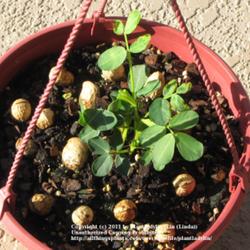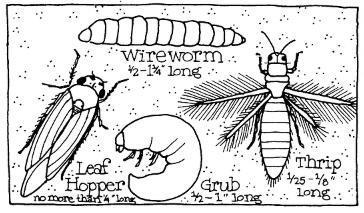
Home gardeners don't have to worry too much about diseases and pests infesting their peanut crop. The most common disease is leaf spot, and the worst insect pests are aphids. The following insects and diseases may appear on your peanut plants:
AphidsAphids can weaken peanut plants as well as spread disease. The 1/16-inch-long light green bugs multiply rapidly, and by sucking sap from plants can cause considerable damage in a short time. Check the plants regularly and control aphids with insecticidal soap sprays.
Leaf SpotLeaf spot is a fungus that's especially prevalent in areas where the weather is warm and moist. Small spots with light centers appear on plant leaves, eventually causing the leaves to turn yellow and drop off. To control leaf spot, rotate crops, plant certified disease-free seeds, remove and burn damaged leaves, and stay away from plants when they're wet.
NematodesNematodes are microscopic eel-like creatures that can be beneficial or harmful. Several species of nematodes plague southern gardeners, stunting plant growth, killing root systems and cutting down yields. In addition to feeding on plant roots, they may also carry and spread disease. Stunted, yellowed and wilted plants are symptomatic of nematode damage. Preventive measures include crop rotation and adding loads of organic matter to your garden before planting. For information on nematode control in your area, contact your Extension Service agent.
LeafhoppersPotato leafhoppers suck on the undersides of leaves, spreading diseases and causing the tips of peanut leaves to turn yellow. These tiny green insects are sometimes referred to as "sharpshooters" because of their wedgelike shape. To prevent leafhopper damage, control weeds around your garden and cover plants with floating row covers. If leafhoppers succeed in infesting your plants, spray with pyrethrum.

Southern corn rootworms bore into young plants and feed on peanut pegs and pods in the soil. These insects can slow healthy growth or even kill entire peanut plants. They're about 1/2 inch long, slender and yellowish white with a brown head. This pest is the larval stage of the spotted cucumber beetle. To control corn rootworms, treat your soil with beneficial nematodes.
ThripsThrips are microscopic pests that can transmit diseases among vegetables - especially in hot, humid climates. If you notice damage in the form of whitish patches on leaves, control with insecticidal soap or destroy severely infested plants.
GrubsWhite grubs live in the soil and feed on the underground parts of peanut plants. The larvae are smooth and grayish white with hard brown heads. Mature grubs have curved 1/2- to one-inch-long bodies with six prominent legs. Control grub damage by growing green manure crops and by not planting peanuts where grass recently grew. Treat the soil with beneficial nematodes or milky spore powder.
WirewormsWireworms vary in color from dark brown to pale yellow and reach 1/2 to 1-1/4 inches long when fully grown. Their segmented bodies are hard and shiny, and like white grubs, wireworms feed on roots and other underground parts of peanut plants. Control wireworms with beneficial nematodes.
 Victory Seed Company has all the seeds you want for your best garden in 2024.
Victory Seed Company has all the seeds you want for your best garden in 2024.
For 25 years, the family-owned Victory Seed Company has provided the highest quality vegetable, herb and flower seeds to families across the country. We are passionate about providing you the best seeds available that give excellent germination, robust plants, and the harvest you want. With a catalog of over a thousand varieties, we have everything, and our prices are the kinds that we'd want to pay. We have hundreds of yesterday's heirloom vegetables, as well as today's award winning hybrid selections. Get to know us by visiting our website and browsing through our online vegetable seed catalog.
| 1. Caring for Peanuts |
| 2. Caring for Peas |
| 3. Watering Peas |
| 4. Pesky Pea Problems |
| 5. Peanut Problems ← you're on this article right now |
| 1. Caring for Peanuts |
| 2. Caring for Peas |
| 3. Watering Peas |
| 4. Pesky Pea Problems |
| 5. Peanut Problems ← you're on this article right now |